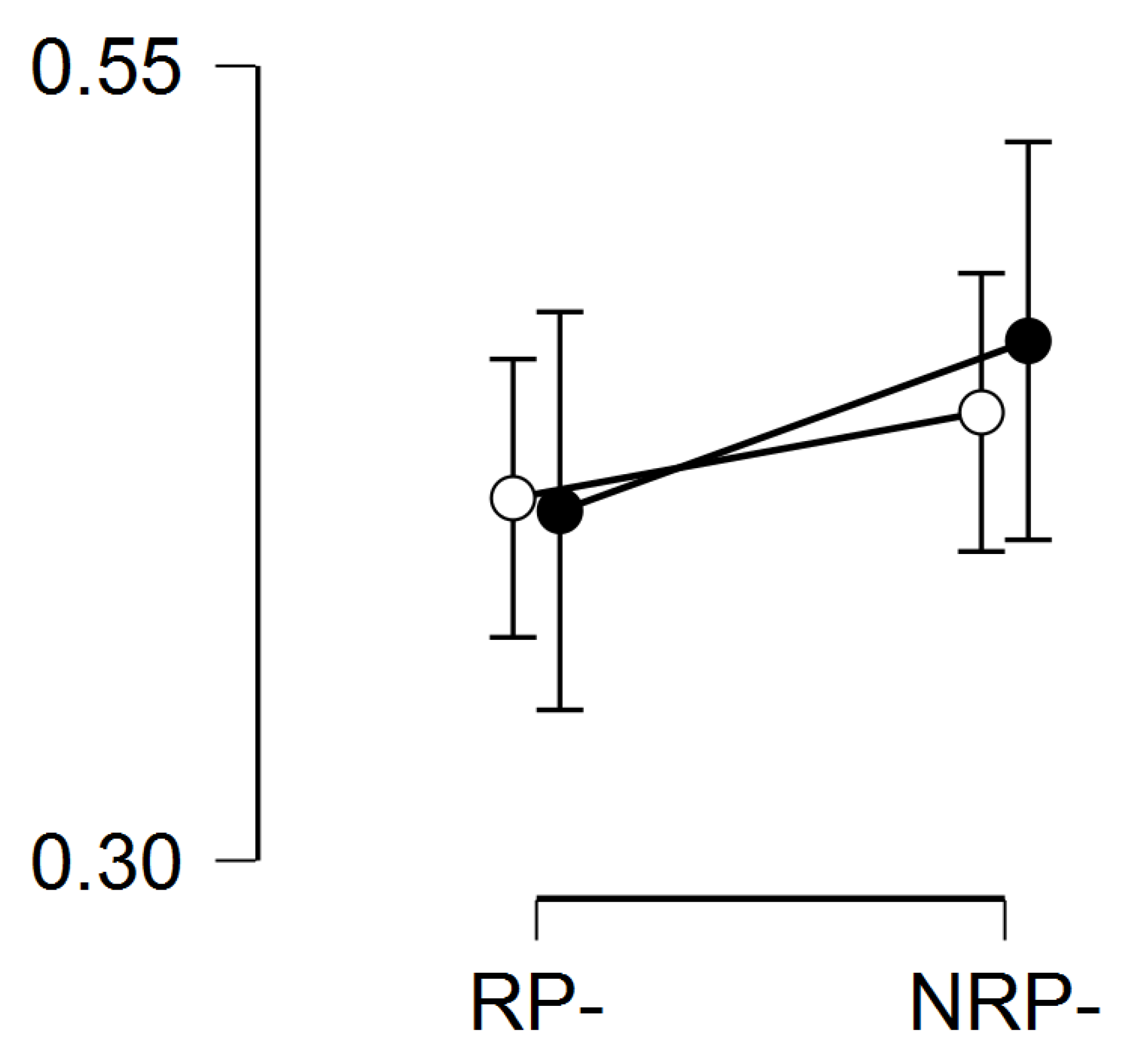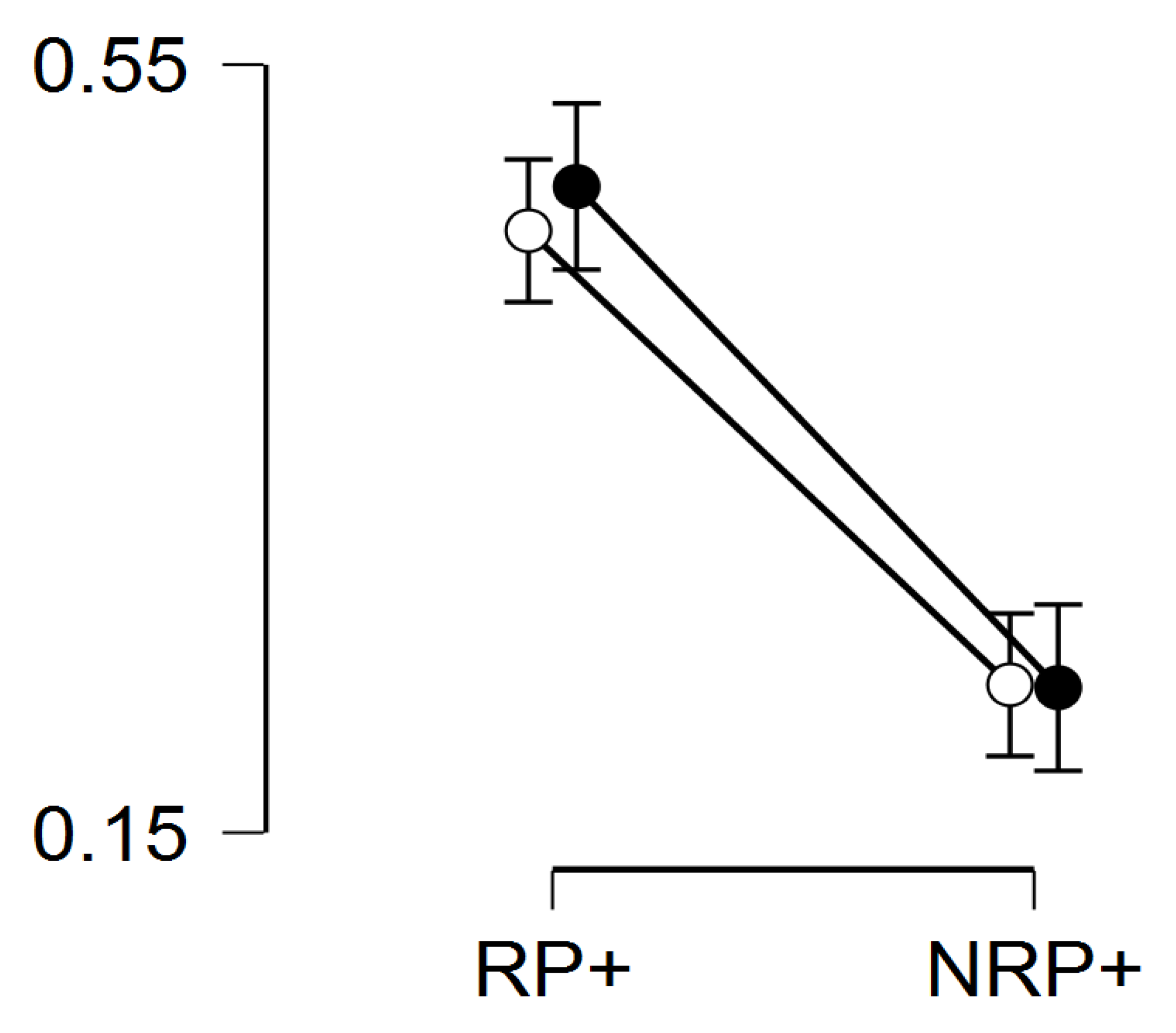Exercise and Retrieval-Induced Forgetting
Abstract
:1. Introduction
2. Methods
2.1. Study Design
2.2. Participants
- Self-reported being pregnant [24]
- Exercised within 5 hours of testing [25]
- Consumed caffeine within 3 hours of testing [26]
- Had a concussion or head trauma within the past 30 days [27]
- Took marijuana or other illegal drugs within the past 30 days [28]
- Were considered a regular alcohol user (>30 drinks/month for women; >60 drinks/month for men) [29]
2.3. Exercise Protocol
2.4. Control Protocol
2.5. Memory Assessment
2.6. Additional Measurements
2.7. Statistical Analysis
3. Results
4. Discussion
Author Contributions
Funding
Conflicts of Interest
References
- Loprinzi, P.D.; Kane, C.J. Exercise and cognitive function: A randomized controlled trial examining acute exercise and free-living physical activity and sedentary effects. Mayo Clin. Proc. 2015, 90, 450–460. [Google Scholar] [CrossRef] [PubMed]
- Crush, E.A.; Loprinzi, P.D. Dose-Response Effects of Exercise Duration and Recovery on Cognitive Functioning. Percept. Mot. Ski. 2017, 124, 1164–1193. [Google Scholar] [CrossRef]
- Frith, E.; Sng, E.; Loprinzi, P.D. Randomized controlled trial evaluating the temporal effects of high-intensity exercise on learning, short-term and long-term memory, and prospective memory. Eur. J. Neurosci. 2017, 46, 2557–2564. [Google Scholar] [CrossRef] [PubMed]
- Sng, E.; Frith, E.; Loprinzi, P.D. Temporal effects of acute walking exercise on learning and memory. Am. J. Health Promot. 2017, 32, 1518–1525. [Google Scholar] [CrossRef] [PubMed]
- Loprinzi, P.D.; Frith, E.; Edwards, M.K.; Sng, E.; Ashpole, N. The effects of exercise on memory function among young-to middle-age adults: Systematic review and recommendations for future research. Am. J. Health Promot. 2017, 32, 691–704. [Google Scholar] [CrossRef]
- Loprinzi, P.D.; Edwards, M.K.; Frith, E. Potential avenues for exercise to activate episodic memory-related pathways: A narrative review. Eur. J. Neurosci. 2017, 46, 2067–2077. [Google Scholar] [CrossRef]
- Loprinzi, P.D.; Ponce, P.; Frith, E. Hypothesized mechanisms through which acute exercise influences episodic memory. Physiol. Int. 2018, 105, 285–297. [Google Scholar] [CrossRef] [Green Version]
- Loprinzi, P.D. IGF-1 in exercise-induced enhancement of episodic memory. Acta Physiol. 2018, 226, e13154. [Google Scholar] [CrossRef]
- Loprinzi, P.D.; Frith, E. A brief primer on the mediational role of BDNF in the exercise-memory link. Clin. Physiol. Funct. Imaging 2018, 39, 9–14. [Google Scholar] [CrossRef]
- Frith, E.; Loprinzi, P.D. Physical activity and individual cognitive funcion parameters: Unique exercise-induced mechansims. J. Cogn. Behav. Psychother. Res. 2018, 7, 92–106. [Google Scholar] [CrossRef]
- Storm, B.C.; Bui, D.C. Retrieval-practice task affects relationship between working memory capacity and retrieval-induced forgetting. Memory 2016, 24, 1407–1418. [Google Scholar] [CrossRef] [PubMed]
- Sng, E.; Frith, E.; Loprinzi, P.D. Experimental effects of acute exercise on episodic memory acquisition: Decomposition of multi-trial gains and losses. Physiol. Behav. 2018, 186, 82–84. [Google Scholar] [CrossRef] [PubMed]
- Loprinzi, P.D.; Blough, J.; Crawford, L.; Ryu, S.; Zou, L.; Li, H. The temporal effects of acute exercise on episodic memory function: Systematic review with meta-analysis. Brain Sci. 2019, 9, 87. [Google Scholar] [CrossRef] [PubMed]
- Hsieh, S.S.; Huang, C.J.; Wu, C.T.; Chang, Y.K.; Hung, T.M. Acute Exercise Facilitates the N450 Inhibition Marker and P3 Attention Marker during Stroop Test in Young and Older Adults. J. Clin. Med. 2018, 7, 391. [Google Scholar] [CrossRef] [PubMed]
- Hung, C.L.; Tseng, J.W.; Chao, H.H.; Hung, T.M.; Wang, H.S. Effect of Acute Exercise Mode on Serum Brain-Derived Neurotrophic Factor (BDNF) and Task Switching Performance. J. Clin. Med. 2018, 7, 301. [Google Scholar] [CrossRef] [PubMed]
- Chen, F.T.; Etnier, J.L.; Wu, C.H.; Cho, Y.M.; Hung, T.M.; Chang, Y.K. Dose-Response Relationship between Exercise Duration and Executive Function in Older Adults. J. Clin. Med. 2018, 7, 279. [Google Scholar] [CrossRef] [PubMed]
- Basso, J.C.; Shang, A.; Elman, M.; Karmouta, R.; Suzuki, W.A. Acute Exercise Improves Prefrontal Cortex but not Hippocampal Function in Healthy Adults. J. Int. Neuropsychol. Soc. 2015, 21, 791–801. [Google Scholar] [CrossRef] [PubMed]
- Loprinzi, P.D. An integrated model of acute exercise on memory function. Med. Hypotheses 2019, 126, 51–59. [Google Scholar] [CrossRef]
- Verde, M.F.; Perfect, T.J. Retrieval-induced forgetting in recognition is absent under time pressure. Psychon. Bull. Rev. 2011, 18, 1166–1171. [Google Scholar] [CrossRef]
- Yanes, D.; Loprinzi, P.D. Experimental Effects of Acute Exercise on Iconic Memory, Short-Term Episodic, and Long-Term Episodic Memory. J. Clin. Med. 2018, 7, 146. [Google Scholar] [CrossRef]
- Siddiqui, A.; Loprinzi, P.D. Experimental Investigation of the Time Course Effects of Acute Exercise on False Episodic Memory. J. Clin. Med. 2018, 7, 157. [Google Scholar] [CrossRef] [PubMed]
- Jubelt, L.E.; Barr, R.S.; Goff, D.C.; Logvinenko, T.; Weiss, A.P.; Evins, A.E. Effects of transdermal nicotine on episodic memory in non-smokers with and without schizophrenia. Psychopharmacology 2008, 199, 89–98. [Google Scholar] [CrossRef] [PubMed] [Green Version]
- Klaming, R.; Annese, J.; Veltman, D.J.; Comijs, H.C. Episodic memory function is affected by lifestyle factors: A 14-year follow-up study in an elderly population. Neuropsychol. Dev. Cogn. B Aging Neuropsychol. Cogn. 2016, 24, 528–542. [Google Scholar] [CrossRef] [PubMed]
- Henry, J.D.; Rendell, P.G. A review of the impact of pregnancy on memory function. J. Clin. Exp. Neuropsychol. 2007, 29, 793–803. [Google Scholar] [CrossRef] [PubMed]
- Labban, J.D.; Etnier, J.L. Effects of acute exercise on long-term memory. Res. Q. Exerc. Sport 2011, 82, 712–721. [Google Scholar] [CrossRef] [PubMed]
- Sherman, S.M.; Buckley, T.P.; Baena, E.; Ryan, L. Caffeine Enhances Memory Performance in Young Adults during Their Non-optimal Time of Day. Front. Psychol. 2016, 7, 1764. [Google Scholar] [CrossRef]
- Wammes, J.D.; Good, T.J.; Fernandes, M.A. Autobiographical and episodic memory deficits in mild traumatic brain injury. Brain Cogn. 2017, 111, 112–126. [Google Scholar] [CrossRef]
- Hindocha, C.; Freeman, T.P.; Xia, J.X.; Shaban, N.D.C.; Curran, H.V. Acute memory and psychotomimetic effects of cannabis and tobacco both ‘joint’ and individually: A placebo-controlled trial. Psychol. Med. 2017, 47, 2708–2719. [Google Scholar] [CrossRef]
- Le Berre, A.P.; Fama, R.; Sullivan, E.V. Executive Functions, Memory, and Social Cognitive Deficits and Recovery in Chronic Alcoholism: A Critical Review to Inform Future Research. Alcohol. Clin. Exp. Res. 2017, 41, 1432–1443. [Google Scholar] [CrossRef]
- Dilley, E.K.; Zou, L.; Loprinzi, P.D. The effects of acute exercise intensity on episodic memory and false memory among young adult college students. Health Promot. Perspect. 2019, 9, 143–149. [Google Scholar] [CrossRef]
- Haynes Iv, J.T.; Frith, E.; Sng, E.; Loprinzi, P.D. Experimental Effects of Acute Exercise on Episodic Memory Function: Considerations for the Timing of Exercise. Psychol. Rep. 2018. [Google Scholar] [CrossRef] [PubMed]
- Green, D.; Loprinzi, P.D. Experimental Effects of Acute Exercise on Prospective Memory and False Memory. Psychol. Rep. 2018. [Google Scholar] [CrossRef] [PubMed]
- Garber, C.E.; Blissmer, B.; Deschenes, M.R.; Franklin, B.A.; Lamonte, M.J.; Lee, I.M. American College of Sports Medicine position stand. Quantity and quality of exercise for developing and maintaining cardiorespiratory, musculoskeletal, and neuromotor fitness in apparently healthy adults: Guidance for prescribing exercise. Med. Sci. Sports Exerc. 2011, 43, 1334–1359. [Google Scholar] [CrossRef] [PubMed]
- McNerney, M.W.; Radvansky, G.A. Mind racing: The influence of exercise on long-term memory consolidation. Memory 2015, 23, 1140–1151. [Google Scholar] [CrossRef] [PubMed]
- Blough, J.; Loprinzi, P.D. Experimental manipulation of psychological control scenarios: Implications for exercise and memory research. Psych 2019, 1, 279–289. [Google Scholar] [CrossRef]
- Ball, T.J.; Joy, E.A.; Gren, L.H.; Shaw, J.M. Concurrent Validity of a Self-Reported Physical Activity “Vital Sign” Questionnaire With Adult Primary Care Patients. Prev. Chronic Dis. 2016, 13, E16. [Google Scholar] [CrossRef] [PubMed]
- Roman, P.; Soriano, M.F.; Gomez-Ariza, C.J.; Bajo, M.T. Retrieval-induced forgetting and executive control. Psychol. Sci. 2009, 20, 1053–1058. [Google Scholar] [CrossRef]
- Thompson, V.A.; Campbell, J.I. A power struggle: Between- vs. within-subjects designs in deductive reasoning research. Psychologia 2004, 47, 277–296. [Google Scholar] [CrossRef]
- Loprinzi, P.D. Intensity-specific effects of acute exercise on human memory function: Considerations for the timing of exercise and the type of memory. Health Promot. Perspect. 2018, 8, 255. [Google Scholar] [CrossRef]
- Rathore, A.; Lom, B. The effects of chronic and acute physical activity on working memory performance in healthy participants: A systematic review with meta-analysis of randomized controlled trials. Syst. Rev. 2017, 6, 124. [Google Scholar] [CrossRef]


| Variable | Exercise (n = 20) | Control (n = 20) |
|---|---|---|
| Age, mean years | 20.45 (0.68) | 20.80 (1.1) |
| Gender, % female | 60.0 | 75.0 |
| Race, % white | 70.0 | 80.0 |
| Body mass index, mean kg/m2 | 25.29 (4.31) | 23.84 (3.1) |
| MVPA, mean min/week | 227.2 (203.0) | 206.2 (197.0) |
| Variable | Exercise (n = 20) | Control (n = 20) |
|---|---|---|
| Heart rate, mean bpm | ||
| Rest | 73.8 (13.7) | 80.3 (14.1) |
| Midpoint | 127.2 (8.4) | 81.0 (13.4) |
| Endpoint | 129.1 (9.2) | 79.4 (12.5) |
| Post | 83.0 (13.8) | 79.3 (11.6) |
© 2019 by the authors. Licensee MDPI, Basel, Switzerland. This article is an open access article distributed under the terms and conditions of the Creative Commons Attribution (CC BY) license (http://creativecommons.org/licenses/by/4.0/).
Share and Cite
Cantrelle, J.; Loprinzi, P. Exercise and Retrieval-Induced Forgetting. Psych 2019, 1, 405-411. https://doi.org/10.3390/psych1010030
Cantrelle J, Loprinzi P. Exercise and Retrieval-Induced Forgetting. Psych. 2019; 1(1):405-411. https://doi.org/10.3390/psych1010030
Chicago/Turabian StyleCantrelle, Justin, and Paul Loprinzi. 2019. "Exercise and Retrieval-Induced Forgetting" Psych 1, no. 1: 405-411. https://doi.org/10.3390/psych1010030





